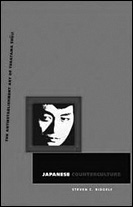Japanese Counterculture: The Antiestablishment Art of Terayama Shuji
by Julian Ross
Despite maintaining legendary cult status in Japan 28 years after his death, Shuji Terayama continues to remain largely unknown in the West. The potential reasons are manifold: his mother was overly protective of his work and, until her fairly recent death, posed difficulties for those eager to translate and disseminate Terayama outputs – something recently rectified by Carol Fisher Sorgenfrei in her book Unspeakable Acts: The Avant-Garde Theatre of Terayama Shuji and Postwar Japan, which included English translations of a selection of his plays.
It is almost morbidly appropriate that Terayama’s relevance is reincarnated in the aftermath of his mother’s death, a demise he obsessively re-imagined throughout his professional career. Mothers were abandoned in his plays, torn up in his photographs, disowned in his films and renounced in his poems: which leads us to another rationale for the deficiency in scholarly attention in the West. Perhaps the lack of attention was due to Terayama’s multidisciplinary identity which refuses to be tied down by generic categories; he feverishly worked between theatre, film, T.V., radio, various forms of poetry and literature, as well sports commentary for boxing and horse-racing. The expansive range of expression and his capabilities to straddle between, across and amongst different media has presumably warned off many scholars under institutional pressure to focus on specific disciplines, yet, as casting our eyes over the chapter titles reveal, this is exactly what drew Steven C. Ridgely to the project.
Ridgely’s impressive study of Shuji Terayama reaches a scope previously unattended by studies of any artistic personality, ranging from discussions on: Terayama’s first radicalized tanka poem; his experiments in radio and stereophonic soundscapes; a funeral he was involved in organizing for a manga character; and his street theatre ventures and cinematic projects. Moreover, what is also remarkable about Ridgely’s account is his continuous ability to link between media throughout his analysis, bouncing between texts by both Terayama and others to weave together a patchwork of intermedial influences, always relevant and grounded in erudite evidence. Ridgley’s reading of Casablanca’s influence on one of Terayama’s early poems is particularly splendid, for it counters the usual chronological and reductive assumption that his poetry fed into his cinema and instead offering a rhizomatic and non-linear mode of analysis that Ridgely appoints throughout the text.
Rather than the psychoanalytical and biographical account of Terayama delivered by Sorgenfrei, Ridgely opts to position Terayama onto a socially mapped history of his generation, further branching out potential linkages for Terayama’s work. His textual analyses are detailed and precise, demonstrating awareness of medium-specific characteristics yet identifying Terayama’s mastery in juggling these properties to conjure new results. Although his book is a celebration of Terayama, Ridgely never falls into the enamored infatuation of Terayama-fanaticism like many Japanese texts on the artist and maintains a critical distance throughout. It takes an analyst with a wide range of academic interests between the arts to cover all aspects of Terayama’s career with such attention to detail, and Ridgely certainly delivers on this account – he claims Terayama as a “decathlete more than a specialist”, and it would be hard not to say the same of Ridgely.
To champion Japanese Counterculture: The Antiestablishment Art of Terayama Shuji as the definitive study on Terayama would not be an overstatement, yet would be impertinent, for Terayama’s output encouraged plural interpretations and raged against fixed readings. Moreover, it would be unfortunate for me to claim Ridgely has finished his work, as, I for one, am looking forward to a follow-up that I’m sure will provide us with even more insight and further configurations of an intricately webbed map of inter-relations. Ridgely has unlocked the key into rooms full of many more doors, leaving some open and keeping others locked, and I hope that his excellent text will not only introduce Terayama to English-language audiences but encourage readers to participate in dialogue about Terayama that is certainly due.
Japanese Counterculture: The Antiestablishment Art of Terayama Shuji is not only a valid contribution to the study of Japanese arts, but a significant addition to the history of global art, where scholars of Orson Welles, Jean Cocteau, Francis Picabia and of other multimedial artists will hopefully follow Ridgely’s remarkable example of engaging with all aspects of an artist’s career.
